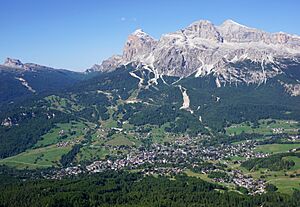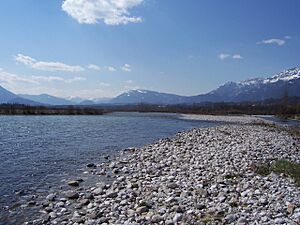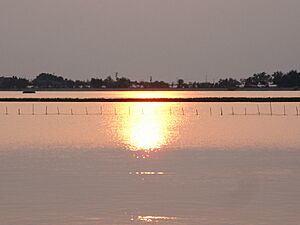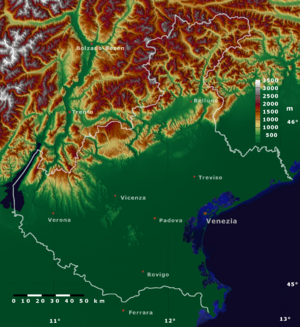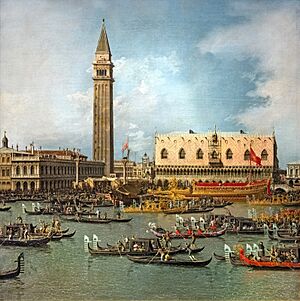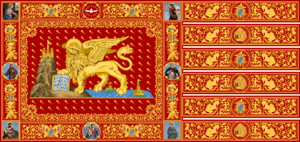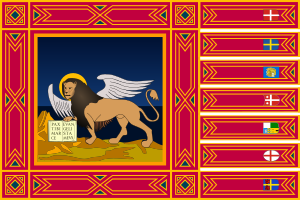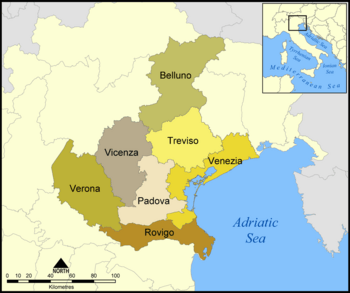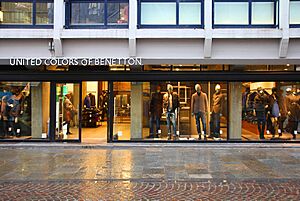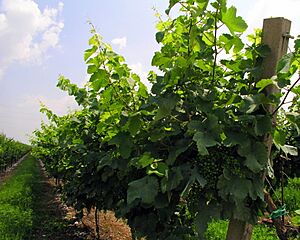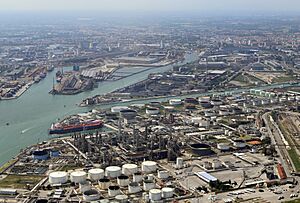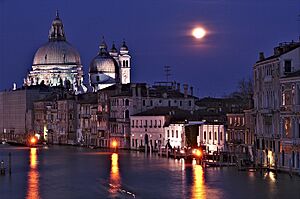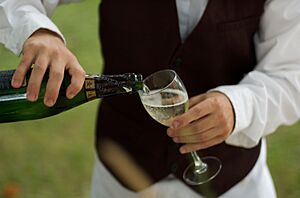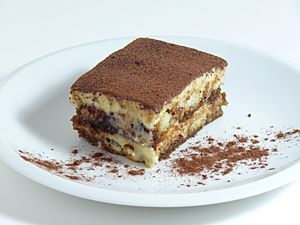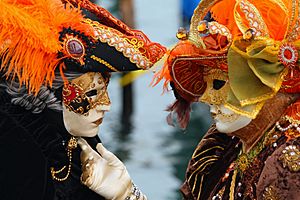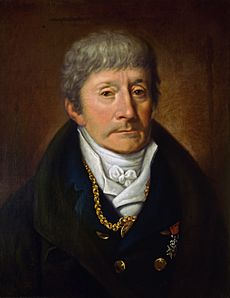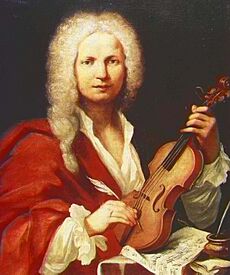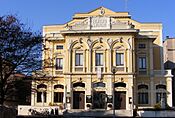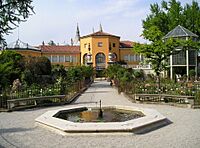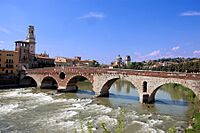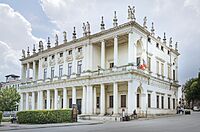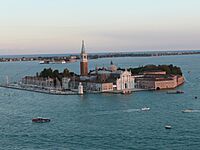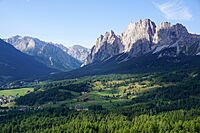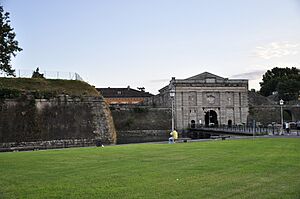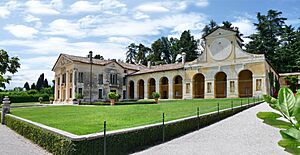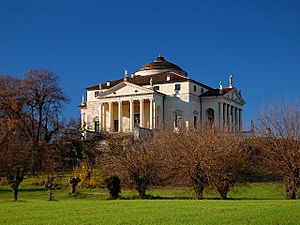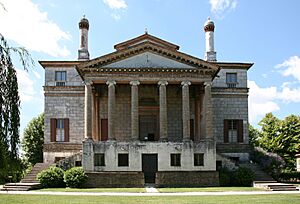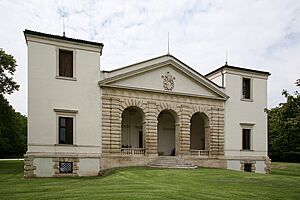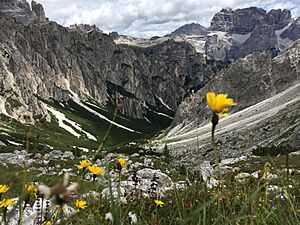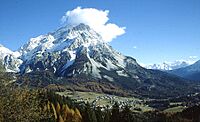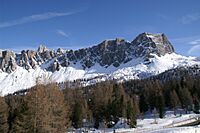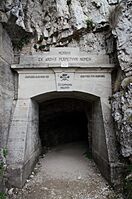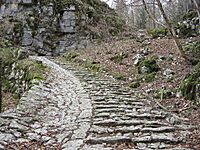Veneto facts for kids
Quick facts for kids
Veneto
Vèneto (Venetian)
Venetia
|
|||
|---|---|---|---|
|
|||
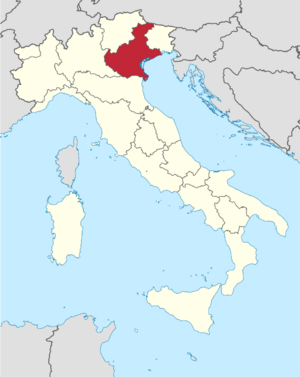 |
|||
| Country | Italy | ||
| Capital | Venice | ||
| Largest city | Verona | ||
| Area | |||
| • Total | 18,345 km2 (7,083 sq mi) | ||
| Population
(2012-10-30)
|
|||
| • Total | 4,865,380 | ||
| • Density | 265.216/km2 (686.905/sq mi) | ||
| Demonym(s) | English: Venetian Italian: veneto (masculine), veneta (feminine) |
||
| Languages | |||
| • Official | Italian | ||
| • Partially recognised | Venetian | ||
| • Minority languages | Cimbrian, Ladin, Friulian (recognised) Emilian (Ferrarese dialect) (other) | ||
| GDP | |||
| • Total | €163.948 billion (2021) | ||
| Time zone | UTC+1 (CET) | ||
| • Summer (DST) | UTC+2 (CEST) | ||
| ISO 3166 code | IT-34 | ||
| HDI (2021) | 0.903 very high · 8th of 21 |
||
| NUTS Region | ITD | ||
| Website | www.regione.veneto.it | ||

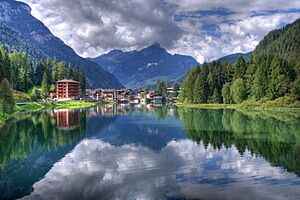
Veneto, also known as Venetia in English, is one of the 20 regions of Italy. It is located in the northeastern part of the country. Veneto is the fourth most populated region in Italy, with about five million people. Venice is its capital city, and Verona is the largest city.
Veneto was once part of the Roman Empire until the 5th century AD. After a time when land was controlled by lords (called a feudal period), it became part of the Republic of Venice until 1797. For centuries, Venice was a powerful trading empire. It was one of the largest and richest maritime republics in the world. After the Napoleonic Wars, Veneto became part of the Austrian Empire. It joined the Kingdom of Italy in 1866. This happened after a war and a public vote.
Most people in Veneto speak Italian. Many also speak Venetian. Since 1971, the law of Veneto has called its people "the Venetian people." The law says Veneto is a "self-governing Region." It is made up of the Venetian people and the lands of several provinces. These include Belluno, Padua, Rovigo, Treviso, Venice, Verona, and Vicenza. The law also says the region should "promote the historical identity of the Venetian people." Even with these statements, Veneto does not have special self-governing powers. Some nearby regions like Friuli-Venezia Giulia and Trentino-Alto Adige/Südtirol do.
Veneto has a strong movement called Venetian nationalism. This group wants more power for the region. The biggest political party in Veneto is Liga Veneta. The current President of Veneto is Luca Zaia. He was re-elected in 2020. In 2017, people in Veneto voted on having more self-rule. Most people (98.1%) voted "yes."
Long ago, many Venetians left their homes to find work. Today, Veneto is a place where many immigrants come to live. In 2018, about 487,493 foreigners lived there. This was about 9.9% of the region's population. Many came from Romania, Morocco, China, Moldova, and Albania.
Contents
- Geography of Veneto
- History of Veneto
- Government and Politics in Veneto
- Divisions of Veneto
- People of Veneto
- Economy of Veneto
- Culture in Veneto
- Tourism in Veneto
- Sister regions
- Notable people
- See also
Geography of Veneto
What is the land like in Veneto?
Veneto is the 8th largest region in Italy. It covers about 18,398.9 square kilometers. It is in the northeastern part of Italy. To the east, it borders Friuli-Venezia Giulia. To the south, it borders Emilia-Romagna. To the west, it borders Lombardy. To the north, it borders Trentino-Alto Adige/Südtirol. It also borders Austria in its northernmost corner.
Veneto stretches about 210 kilometers from north to south. About 29% of the region is mountainous. These mountains include parts of the Carnic Alps and the eastern Dolomites. The highest mountain in the Dolomites is the Marmolada-massif, which is 3,342 meters tall. Other famous peaks are the Tre Cime di Lavaredo. The Venetian Prealps are lower, between 700 and 2,200 meters. These mountains have many caves. The Spluta Della Preta is the deepest cave in Italy, going down 985 meters. Many fossils are also found here.
The Po Valley covers 57% of Veneto. It stretches from the mountains to the Adriatic Sea. There are some low hills in the plain, like the Euganean Hills. These hills make up 14% of the land. The plain has two parts. The higher plain has gravel and is not very fertile. The lower plain has many water sources and good farming land. This lower plain is important for farming and is where most people live.
Many rivers flow through Veneto. These include the Po, Adige, Brenta, Bacchiglione, Livenza, Piave, and Tagliamento. The eastern side of Lake Garda, Italy's largest lake, is in Veneto. The coastline is about 200 kilometers long. About 100 kilometers of this are beaches.
The Adriatic Sea coast has the Venetian Lagoon. This is a flat area with ponds, marshes, and islands. The Po Delta in the south has sandbars and dunes. The land inland has been reclaimed for farming using canals and dykes. There are also fish ponds. The delta and lagoon are important resting spots for migratory birds.
Veneto's land is divided into:
- Mountains (montagna): 5,359.1 square kilometers.
- Hills (collina): 2,663.9 square kilometers.
- Plains (pianura): 10,375.9 square kilometers, mostly in the Po Valley.
What is the weather like in Veneto?
The climate in Veneto changes a lot. It is a continental climate on the plains. This means hot summers and cold winters. It is milder along the Adriatic coast and around Lake Garda. In winter, the lowlands often have thick fog. Rainfall is low near the Po River, about 750 mm per year. It is higher in the mountains, from 750 to 1,100 mm per year. The Bellunese Prealps get the most rain, up to 3,200 mm per year.
History of Veneto
Who lived in Veneto long ago?
Between 2000 and 1000 BC, the Euganei people lived in this region. Later, the Veneti arrived. Some stories say they came from a place called Paphlagonia around the time of the Trojan War. Other historians think they were linked to the Celts.
By the 7th and 6th centuries BC, the Veneti met the Etruscans and Greeks. Their culture became very strong in the 4th century BC. The ancient Veneti spoke Venetic. This was an Indo-European language, similar to Latin. The Veneti became rich by trading amber and raising horses. Cities like Este, Padua, and Verona became important centers for their culture. Over time, the Veneti started to adopt some customs from their Celtic neighbors.
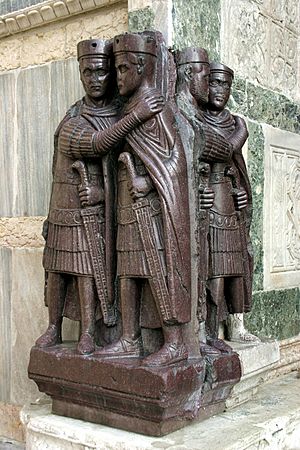
How did the Romans come to Veneto?
In the 3rd century BC, the Veneti joined forces with the Romans. They helped Rome fight against other Celtic tribes. During the Second Punic War (218–202 BC), the Veneti even sent soldiers to fight with the Romans against Hannibal.
In 181 BC, the Romans built a colony called Aquileia. This was to protect the Veneti from other tribes. Roman influence grew stronger. In 148 BC, the Via Postumia road was finished. It connected Aquileia to Genoa.
The Roman Republic slowly gained control over the Veneti. In 49 BC, the Veneti were given full Roman citizenship. By AD 46, the Via Claudia Augusta road was completed. It connected many cities in the region.
Around 8–6 BC, the Roman emperor Augustus divided Italy into 11 regions. Modern Veneto became part of Region X, called Venetia et Histria. Aquileia was the main city. Under Roman peace, Padua grew into an important city. Other Venetian cities also adopted the Latin language and Roman culture. By the end of the 1st century AD, Latin had replaced the original Venetic language.
In 166 AD, barbarian tribes invaded Venetia. This was the start of many invasions. In 452 AD, Attila and the Huns destroyed Aquileia. Many people from the mainland moved to the nearby lagoons for safety. These lagoons later became Grado and Venice. After the Huns, the Ostrogoths invaded and settled in the region.
In the mid-6th century, Justinian brought Venetia back under the Eastern Roman Empire. But this Greek-Byzantine rule did not last long. In 568 AD, the Lombards invaded. They divided Venetia into many smaller areas. This separated Veneto from Friuli. The Lombard invasion caused more people to move to the coast and islands. By 643 AD, the Lombards controlled almost all of Veneto, except for Venice and Grado.
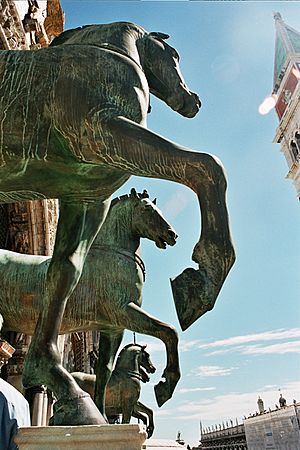
What happened in the Middle Ages?
By the mid-8th century, the Franks took control of mainland Veneto. It became part of the Carolingian Empire. Over time, these Germanic invaders blended in with the Venetian people.
In the 10th century, after attacks from the Magyars and Slavs, mainland Veneto became part of the Holy Roman Empire. Slowly, the cities on the mainland grew stronger and richer. In 1167, cities like Padua, Treviso, Vicenza, and Verona formed an alliance. This was called the Lombard League. They wanted to protect their rights against the Holy Roman Emperor.
The emperor Frederick I fought six wars in Italy. He was defeated at the Battle of Legnano in 1176. Peace talks happened in Venice in 1177. The doge of Venice, Sebastiano Ziani, helped with the talks. The Second Treaty of Constance in 1183 confirmed that cities could rule their own lands. The league ended in 1250. During this time, the University of Padua was founded in 1222. St. Anthony, a beloved saint, also lived in Padua.
How did the Venetian Republic rise?
When barbarians invaded, some Venetians found safety on islands in the lagoon. This is how the city of Venice began. After a period of Byzantine rule, Venice became an independent Republic. It was ruled by an elected leader called a doge.
The Republic became a powerful trading nation. Its influence lasted through the Middle Ages and the Renaissance. The Venetian Republic was powerful for 1100 years. By the 16th century, Venice controlled Veneto, Friuli, parts of Lombardy, Romagna, Istria, Dalmatia, and several islands.
Venice's control of mainland areas led it to be involved in European politics. Cities had to be protected with strong walls. The "Serenissima" (most serene republic) ruled wisely. This made the mainland cities happy to be part of Venice. But as the Ottoman Empire grew, Venice had to defend itself. New sea routes to Asia and the discovery of the Americas also hurt Venice's economy.
In 1797, Napoleon invaded the Venetian Republic. The last Doge, Ludovico Manin, resigned. The thousand-year-old Republic ended as an independent state. This was not popular in the mainland cities. By the Treaty of Campo Formio, parts of Veneto were given to the Holy Roman Empire. Other parts were taken by the French-backed Cisalpine Republic. The area later went back to Napoleon in 1801.
What was Habsburg rule like?
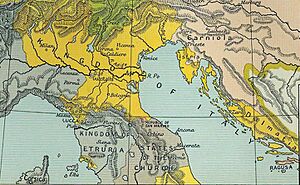
In 1805–1806, Napoleon's armies conquered Veneto. It became part of the Kingdom of Italy. In 1809, the region rebelled against French-Italian rule. They supported the Austrian troops. After the Congress of Vienna (1814–1815), Venetia became the eastern half of the Kingdom of Lombardy–Venetia. This was a separate kingdom within the Austrian Empire.
During the First Italian War of Independence in 1848, Venetia rebelled against Austria. It formed the Republic of San Marco. After 17 months, it wanted to join the Kingdom of Sardinia. But other Italian states left the war. Sardinia surrendered. Venetia was left alone and surrendered in 1849.
The Austrian government was not popular with the rich and middle classes. This was because of its strict policies. However, many people, especially the poor, liked its efficient and honest rule. After 1849, there were no more revolts against Austrian rule.
How did Veneto join Italy?

Venetia stayed under Austrian control until 1866. This was when the Austro-Prussian War happened. The Kingdom of Italy joined the war on the Prussian side. Italy was promised Venetia if they helped. Austria offered to sell Venetia to Italy, but Italy refused. This led to a new war front for Austria, called the Third Italian War of Independence.
After the wars, the Treaty of Vienna gave the region to neutral France. But the forts stayed under Austrian control for a while. After protests, the Austrians left. France then gave Venetia to Italy on October 20. A public vote was held on October 21–22. Only 30% of adults voted, and they were pressured by the government. But 99.99% voted to join Italy. During the fascist era, the Venetian language was banned in public places.
Poor economic growth caused many people to leave Veneto in the 19th and early 20th centuries. Millions of Venetians moved to other parts of the world. Many settled in South America, Australia, Canada, and the USA. After World War II, many Venetians moved to Western European countries. Their descendants often still speak Venetian dialects.
Those who stayed in Veneto lived through two World Wars. In 1915, Italy joined World War I. Veneto became a major battleground. After a big defeat in 1917, Austrian and German forces advanced into Veneto. They reached the Piave River. The Battle of the Piave River stopped them from going further. This battle is famous in Italy. In October 1918, Italy won the decisive Battle of Vittorio Veneto. The war ended for Italy and Austria-Hungary with a peace agreement signed near Padua.
Between 1943 and 1945, Veneto was part of the Italian Social Republic. Many towns were bombed by the Allies during World War II. Treviso and Vicenza were hit hard.
Government and Politics in Veneto
How is Veneto governed?
Veneto is a semi-presidential democracy. This means it has a president and a parliament. The President of Veneto is also called the Governor. Some even call him "Doge," like the old rulers of Venice. The President leads the Regional Government. The Regional Council is the local parliament. It makes laws.
The law of Veneto, called the Statute of Veneto, was first made in 1971. It calls Venetians "people." But this does not give them special legal rights compared to other Italian citizens. Also, Veneto does not have as much self-rule as nearby regions like Friuli-Venezia Giulia and Trentino-Alto Adige/Südtirol. Because of this, many towns have voted to try and join those regions.
Veneto has traditionally been a very Catholic region. It was once the main area for the Christian Democracy party. This party won many votes and governed the region from 1970 to 1994. After that, Veneto became a stronghold for the center-right political group. This group has governed the region since 1995. First, under President Giancarlo Galan, and since 2010, under Luca Zaia. In the 2020 regional election, Luca Zaia's party won a lot of votes.
Experts say that Veneto's regional government works better than average in Italy. Veneto is considered part of the "civic North" of Italy.
What is Venetian nationalism?
Venetian nationalism is a political movement. It became popular in Veneto in the 1970s and 1980s. This movement wants more self-rule, special laws, or even independence for Veneto. It also promotes Venetian culture, language, and history. The Liga Veneta party was started in 1980 because of this movement. Other groups also want independence, but Liga Veneta is the most popular. It helped create the Lega Nord party in 1991.
Groups like Venetian Independence have long wanted a vote on Veneto becoming independent from Italy. In 2012, the Regional Council supported the idea of a vote. An online vote was held in 2014, but it was not official. The organizers said many people voted "yes" for independence. However, some news sources questioned these numbers.
On October 22, 2017, an official vote on self-rule took place in Veneto. About 57.2% of Venetians voted. Of those, 98.1% voted "yes" for more self-rule.
Divisions of Veneto
How is Veneto divided?
Veneto is divided into the Metropolitan City of Venice and 6 provinces. It also has 581 smaller areas called municipalities. The Province of Padua has the most people and is the most crowded. It has 424.81 people per square kilometer. The city of Padua itself has 2268.58 people per square kilometer. Venice, the capital, has a moderate population density of 646.71. The Belluno province has the fewest people per square kilometer (58.08). It is the largest in size and has the most mountains.
Main cities and their populations
| Province | Abbrev. | Area (km2) | Population | Density (inh./km2) |
|---|---|---|---|---|
| Belluno | BL | 3,678 | 213,059 | 57.9 |
| Padua | PD | 2,141 | 905,112 | 422.8 |
| Rovigo | RO | 1,789 | 245,598 | 137.3 |
| Treviso | TV | 2,477 | 865,194 | 349.3 |
| Venice | VE | 2,463 | 841,609 | 341.7 |
| Verona | VR | 3,121 | 889,862 | 285.1 |
| Vicenza | VI | 2,722 | 848,642 | 311.8 |
| Pos. | Municipality | Inhabitants (inh.) | Area (km2) | Density (inh./km2) | Elevation (m amsl) | Province |
|---|---|---|---|---|---|---|
| 1 | Verona | 259,608 | 206.63 | 1,269.9 | 59 | VR |
| 2 | Venice | 259,150 | 412.54 | 651.4 | 1 | VE |
| 3 | Padua | 209,696 | 92.85 | 2,258.4 | 12 | PD |
| 4 | Vicenza | 113,969 | 80.54 | 1,415.1 | 39 | VI |
| 5 | Treviso | 81,665 | 55.50 | 1,741.4 | 15 | TV |
| 6 | Rovigo | 51,378 | 108.55 | 473.3 | 6 | RO |
| 7 | Chioggia | 50,880 | 185.20 | 274.7 | 2 | VE |
| 8 | Bassano del Grappa | 42,237 | 46.79 | 902.7 | 129 | VI |
| 9 | San Donà di Piave | 41,827 | 78.73 | 505.2 | 3 | VE |
| 10 | Schio | 38,779 | 67.04 | 578.4 | 200 | VI |
People of Veneto
How many people live in Veneto?
| Historical population | ||
|---|---|---|
| Year | Pop. | ±% |
| 1871 | 2,196,000 | — |
| 1881 | 2,346,000 | +6.8% |
| 1901 | 2,580,000 | +10.0% |
| 1911 | 3,009,000 | +16.6% |
| 1921 | 3,319,000 | +10.3% |
| 1931 | 3,487,000 | +5.1% |
| 1936 | 3,566,000 | +2.3% |
| 1951 | 3,916,506 | +9.8% |
| 1961 | 3,845,039 | −1.8% |
| 1971 | 4,121,997 | +7.2% |
| 1981 | 4,343,668 | +5.4% |
| 1991 | 4,379,424 | +0.8% |
| 2001 | 4,526,335 | +3.4% |
| 2011 | 4,855,904 | +7.3% |
| 2021 | 4,847,745 | −0.2% |
| Source: ISTAT | ||
Veneto has about 4.8 million people. It is the fifth most populated region in Italy. Veneto has a high population density, with about 265 people per square kilometer in 2008. This is especially true in the provinces of Padua, Venice, and Treviso. These areas have over 300 people per square kilometer. Belluno is the least crowded province, with only 57 people per square kilometer.
Like other regions in Northern and Central Italy, Veneto's population is growing very slowly. This is because fewer babies are being born. The population has only increased a little due to people moving into the region. This started in the late 1980s, after many years of people leaving poorer areas of Veneto.
Where do people in Veneto come from?
| Nationality | Population |
|---|---|
| 124,533 | |
| 44,837 | |
| 34,777 | |
| 32,376 | |
| 31,052 | |
| 17,517 | |
| 16,207 | |
| 15,634 | |
| 14,363 | |
| 13,031 |
Nearly 3 million Venetians left their homes between 1861 and 1961. They left to escape poverty. Many moved to Brazil and Argentina. After World War II, they moved to other European countries. In 2008, about 260,849 Venetian citizens lived outside Italy. Many were in Brazil, Switzerland, and Argentina. There are millions of people of Venetian descent around the world. Especially in Brazil, in the states of Rio Grande do Sul, Santa Catarina, and Paraná. Some towns in Southern Brazil have names like Nova Schio and Nova Veneza. These names show the Venetian origin of their people. In recent years, people of Venetian descent from Brazil and Argentina have been moving back to Italy.
Because of strong economic growth in the last 20 years, Veneto has become a place where many immigrants come to live. Since the 1990s, more and more immigrants have moved there. In 2008, Italy's statistics office estimated that 403,985 foreign-born immigrants lived in Veneto. This was 8.3% of the total population.
What religions are practiced in Veneto?
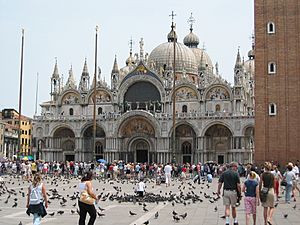
Veneto became Christian during Roman rule. The region honors St. Hermagoras and St. Fortunatus as its patron saints. They were both martyrs from Aquileia. Aquileia became a very important church center for Venetia. It had its own special church services. These were used throughout Veneto until later in the Middle Ages. Then, the Roman way of worship took over.
In the 6th century, the bishop of Aquileia claimed the title of patriarch. This led to a split with the Church of Rome. The split lasted until 699 AD.
In 2004, over 95% of the people in Veneto said they were Roman Catholic. Veneto, along with Friuli and Trentino-Alto Adige/Südtirol, forms a church region called Triveneto. The Patriarchate of Venice is the main church authority. It oversees other church areas like Padua, Treviso, and Verona.
The church area of Venice became an honorary Patriarchate in 1457. This happened when the Patriarchate of Grado was closed. The first patriarch of Venice was St. Laurence. In the 20th century, the patriarchs were often made cardinals. Three cardinal patriarchs from Venice were later elected pope. These were Pius X, John XXIII, and John Paul I. The Patriarchate of Venice considers St. Mark the Evangelist as its patron. St. Mark, shown as a winged lion, was also the symbol of the Venetian Republic. This symbol is still seen on many city emblems today.
Economy of Veneto
How does Veneto make money?
Under Austrian rule, Veneto's farming economy struggled. This led to many people leaving the region. But since the 1970s, Veneto has grown a lot. This is thanks to its "Veneto development model." This model focuses on businesses that sell goods to other countries. These businesses are often in traditional areas like clothing or furniture. Veneto is the third richest region in Italy in terms of total GDP.
The land and history of Veneto have shaped its economy. A wide belt running from east to west is the most developed area. This includes the plains and the foothills of the Alps. The Po delta and mountain areas are less developed. The Alps and the province of Rovigo are seeing their populations shrink and get older.
What is farming like in Veneto?
Farming is still important in Veneto, even though its role has decreased. Veneto's farming sector is one of the most productive in Italy. It uses a lot of human labor, not just machines. This is because it specializes in growing vegetables, fruits, and grapes. These crops need a lot of hand work. In the south and far east of the region, grain crops are more common. Farms there are larger and use more machines. Raising cattle is also important, making up 15% of Italy's total. Fishing is also key in coastal areas.
Main farm products include maize, green peas, vegetables, apples, and cherries. They also grow sugar beets, tobacco, and hemp. Veneto is a very important area for making wines. Famous wines include Prosecco, Valpolicella, and Soave. Veneto makes more high-quality DOC wines than any other area in Italy. Amarone della Valpolicella, a red wine from Verona, is one of the most expensive in the world.
What industries are in Veneto?
In the last 30–40 years, industries have changed the look of the landscape. This is especially true in the plains.
Veneto's industry is mostly made up of small and medium-sized businesses. They work in many areas. These include food, wood and furniture, leather and shoes, textiles and clothing, and gold jewelry. They also work in chemistry, metal, and electronics. This has created a system where many industries sell their products to other countries.
Veneto is known for its industrial districts. This means each area specializes in a certain type of industry. The province of Venice has large metal and chemical factories in Marghera and Mestre. But it is also known for glass crafts in Murano. The province of Belluno is famous for eyeglasses. The world's largest eyeglass maker, Luxottica, is based there. Other important companies are Safilo and De Rigo.
The fashion industry is very strong across the region. Brands like Benetton, Bottega Veneta, Geox, and Diesel are all from Veneto.
Many Venetian companies have moved their factories to Eastern Europe in the last 20 years. Especially the more dangerous or polluting ones. The Romanian city of Timișoara is even called "the newest Venetian province."
How important is tourism in Veneto?

Even though Veneto has a lot of industry, tourism is one of its main ways to make money. One-fifth of all foreign tourists in Italy visit Veneto. It is the top region in Italy for tourist visits, attracting over 60 million visitors each year. The tourism business in Veneto is worth about 12 billion Euros.
Veneto has many small and beautiful villages. Eleven of them are listed among "The most beautiful Villages of Italy." These include Arquà Petrarca, Asolo, and Malcesine.
Economic Statistics
How has Veneto's economy grown?
| 2000 | 2001 | 2002 | 2003 | 2004 | 2005 | 2006 | 2015 | |
|---|---|---|---|---|---|---|---|---|
| Gross Domestic Product (million €) | 111,713.5 | 116,334.1 | 118,886.3 | 124,277.6 | 130,715.9 | 133,488.0 | 138,993.5 | 166,400 |
| GDP per capita (PPP) (€) | 24,842.9 | 25,742.2 | 26,108.2 | 26,957.1 | 27,982.2 | 28,286.7 | 29,225.5 | 33,500 |
What are the main parts of Veneto's economy?
| Economic activity | GDP product | % sector (region) | % sector (Italy) |
| Primary (agriculture, farming, fishing) | €2,303.3 | 1.66% | 1.84% |
| Secondary (industry, processing, manufacturing) | €34,673.6 | 24.95% | 18.30% |
| Constructions | €8,607.7 | 6.19% | 5.41% |
| Tertiary (Commerce, hotels and restaurants, tourism, (tele)communications and transport) | €28,865.8 | 20.77% | 20.54% |
| Financial activities and real estate | €31,499.4 | 22.66% | 24.17% |
| Other types of services | €19,517.2 | 14.04% | 18.97% |
| VAT and taxes | €13,526.4 | 9.73% | 10.76% |
| GDP of Veneto (2020) | €163 billion |
What is the unemployment rate in Veneto?
The unemployment rate in Veneto was 5.8% in 2020. This was lower than the national average for Italy. However, Veneto was one of the few northern regions where unemployment went up between 2017 and 2018.
| Year | 2006 | 2007 | 2008 | 2009 | 2010 | 2011 | 2012 | 2013 | 2014 | 2015 | 2016 | 2017 | 2018 | 2019 | 2020 |
|---|---|---|---|---|---|---|---|---|---|---|---|---|---|---|---|
| unemployment rate (in %) |
4.1% | 3.4% | 3.4% | 4.7% | 5.7% | 4.9% | 6.4% | 7.6% | 7.5% | 7.1% | 6.8% | 6.3% | 6.4% | 5.7% | 5.8% |
Culture in Veneto
What kind of art and buildings are in Veneto?
In the Middle Ages, many grand buildings were made. Examples include churches on the island of Torcello in the Venetian lagoon. The Cathedral of Santa Maria Assunta was founded in 639. The Basilica of San Zeno Maggiore in Verona is another important example. The Scaliger Tombs in Verona show Gothic art.
Giotto brought new painting styles to Padua around 1302. He painted the Scrovegni Chapel, which is a very important art site. His influence was seen in other frescoes in Padua.
After the Gothic art period, the Renaissance brought new styles. Important works include the Ca' d'Oro and the Doge's Palace in Venice. Andrea Mantegna (1431–1506) was an important Renaissance artist. His San Zeno Altarpiece is in Verona. Other artists like Vittore Carpaccio and Giovanni Bellini helped start the age of Venetian painting.
Padua was a key place for the Venetian Renaissance. Artists like Donatello worked there. Pisanello's works are mostly in Verona.

Later artists like Giorgione and Titian developed a unique style. They used color to create atmosphere, rather than relying on perfect drawings. Titian, from Belluno, became very famous across Europe.
Tintoretto (1518–1594) used a Venetian style of painting. He used color to show shapes and created unusual perspectives. His studio made many paintings for palaces and churches in Venice. Paolo Veronese (1528–1588) also painted many works celebrating Venice. He decorated the Palazzo Ducale and many villas.
In architecture, Andrea Palladio (1508–1580) created very influential works. These include Villas on the mainland and buildings in Venice. His villa designs were inspired by ancient Roman villas. This style, called Palladianism, became very popular for centuries. His student Vincenzo Scamozzi finished many of his works, including the Teatro Olimpico in Vicenza.
The 18th-century Venetian school had many great artists. Giambattista Tiepolo was a famous painter known for his large ceiling decorations. He used perspective to make figures look like they were floating.
Canaletto (1697–1768) and Francesco Guardi (1712–1793) were famous for their landscape paintings. Canaletto's paintings were very realistic, almost like photos. Guardi's were more imaginative.
Antonio Canova (1757–1822), from Possagno, was a great neoclassical sculptor. He designed and helped build the Temple of Possagno. His famous sculptures include Psyche Revived by Love's Kiss.
After the fall of the Republic of Venice in 1796, each city in Veneto developed its own art. The Accademia di Belle Arti in Venice attracted many young artists.
What about education in Veneto?

Veneto is home to one of the oldest universities in the world, the University of Padua. It was founded in 1222. Studies show that students in North-Eastern Italy, mostly from Veneto, have the highest school achievements in Italy. In 2003, the University of Padua had about 65,000 students.
What languages are spoken in Veneto?
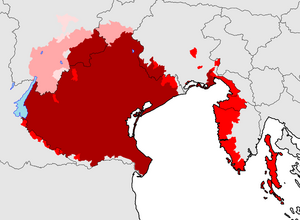
Most people in Veneto speak Italian. Many also speak local versions of the Venetian language. There are different Venetian dialects depending on the city or area. For example, dialects in Venice, Padua, Verona, and Belluno are all a bit different.
Venetian dialects are part of the Western Romance family. They come from Vulgar Latin. They have also been influenced by Italian. Venetian was first written down in the 13th century. It is also spoken outside Veneto. You can find it in parts of Croatia, Slovenia, and Brazil.
Famous Venetian-language writers include the playwrights Carlo Goldoni (1707–1793) and Carlo Gozzi (1720–1806).
Ladin, another Romance language, is spoken in parts of the province of Belluno. This includes towns like Cortina d'Ampezzo. Cimbrian, a Germanic language, is spoken in two villages. These villages are part of historical groups called the Seven Communities and the Thirteen Communities. Also, in the area around Portogruaro, people speak Friulian.
Veneto does not have special self-rule. So, these minority languages do not have official recognition. However, the regional parliament has voted to recognize Venetian as an official regional language.
What is Venetian cuisine like?
Food is a very important part of Veneto's culture. The region is known for some of the most famous dishes, desserts, and wines in Italy and the world.
Wines and drinks from Veneto
Veneto is a key area for wine production. It makes wines like Soave, Bardolino, Recioto, Amarone, and Prosecco. Making homemade wine is common. After making wine, the leftover grapes are used to make grappa, a strong alcoholic drink.
Prosecco is a dry, sparkling wine. It is made from the glera grape. This grape is traditionally grown in the hills north of Treviso. The name Prosecco comes from the village of Prosecco, where the grape is thought to have started.
Spritz, also called "spriss" or "spriseto" locally, is a popular drink. It usually has equal parts sparkling wine, Aperol, and sparkling water. Sometimes Campari is used instead of Aperol.
Cheeses from Veneto
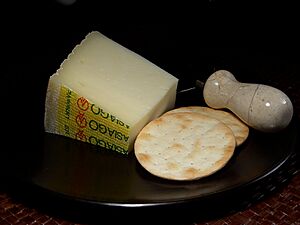
Cheeses from Veneto include Asiago, Piave, and Monte Veronese. These are all special cheeses with protected names.
Meats from Veneto
The sopressa vicentina is a type of aged salami. It is made from high-quality pork. It can have garlic or not. Prosciutto Veneto Berico-Euganeo is a delicate, sweet, and fragrant ham.
Vegetables from Veneto
Radicchio rosso di Treviso is a special vegetable. It has a slightly bitter taste and a crunchy texture. It is grown in areas around Treviso, Padua, and Venice. The radicchio Variegato di Castelfranco has a delicate and slightly sweet taste. Veronese Vialone Nano Rice from Verona is a type of rice used in risotto dishes. It has short, plump grains and a creamy texture when cooked. The Bean of Lamon is known for its delicate flavor and tender skin. The White Asparagus of Cimadolmo has a special scent and delicate taste. The White Asparagus of Bassano is from the northern part of the province of Vicenza. The San Zeno di Montagna chestnut also has a protected status.
Desserts from Veneto
Tiramisù is a famous dessert that comes from Veneto. It is made with mascarpone cheese, coffee, Marsala wine, savoiardi biscuits, and chocolate.
What festivals are celebrated in Veneto?
Each town, and often each neighborhood, celebrates its patron saint's day. Many other festivals are linked to the religious calendar. Some of these include:
- Carnival of Venice: celebrated the Tuesday before Ash Wednesday.
- Panevin: celebrated around Epiphany.
- Pasqua: Easter Sunday.
- Saint Mark's feast day: April 25.
- La Sensa: Ascension Thursday.
- San Giovanni Battista: June 24.
- La festa del Redentór: mid-July.
- Vendemmia: grape harvest in September.
- San Nicolò de Bari: St. Nicholas, December 6.
- Nadàl: Christmas.
What kind of music is in Veneto?

Veneto, especially Venice and Verona, are important music centers in Italy. They have a lively music scene.
Venice was often called the "Republic of Music" in the past. People said there was music everywhere.
In Padova, you can find music groups like the Amici della Musica di Padova and the Solisti Veneti. Concerts are often held in the historic Loggia Comaro. Padua also has several theaters and a music school.
Rovigo has the Teatro Sociale, built in 1819. Famous musicians started their careers there. Rovigo also has a music school.
The city of Verona has the Roman amphitheater called the "Arena." It has hosted music events since the 16th century. Today, it is famous for its outdoor opera shows, especially Verdi's Aida. Verona also has a music school.
Famous musicians and composers from Veneto
- Claudio Monteverdi (1567–1643): A composer and opera pioneer.
- Antonio Vivaldi (1678–1741): A famous violinist and composer of Baroque music.
- Antonio Salieri (1750–1825): A conductor and composer of classical music and operas.
- Mario Brunello (1960 – ): A world-famous cellist.
- Rondo Veneziano: An Italian music group that mixes Baroque music with pop music and rock.
Theaters in Veneto

- Teatro La Fenice in Venice: This is the main opera house in Venice. It has been rebuilt many times after fires. It hosts important opera seasons and a festival for modern music.
- Teatro Malibran in Venice: An old Venetian theater.
- Teatro Stabile del Veneto "Carlo Goldoni" in Venice: This theater opened in 1622. It is near the Rialto bridge. It hosts plays, operas, concerts, and ballets.
- Teatro Verdi (Padua) in Padua: The main theater in Padua. It opened in 1751.
- Teatro Olimpico in Vicenza: Designed by Andrea Palladio in 1580. It is considered the first modern indoor theater. Its wooden stage sets are still in excellent condition. It is a UNESCO World Heritage Site.
- Philharmonic Theater (Verona) in Verona: The main opera house in Verona.
- Roman Theatre of Verona: Verona's main ancient Roman theater. It is used for plays and operas in the summer.
- Teatro Salieri in Legnago, Verona.
Tourism in Veneto
What cities should you visit in Veneto?
- Venice: Venice and its lagoon are World Heritage Sites by UNESCO.
- Padua: Known as the "City of the Saint." Its botanical garden and 14th-century frescoes are also UNESCO World Heritage Sites.
- Verona: The city of Shakespeare's Romeo and Juliet. Verona is a UNESCO World Heritage Site.
- Vicenza: A UNESCO World Heritage Site, along with many Palladian Villas.
- Belluno: The capital of the Dolomites.
- Montagnana: A town with perfectly preserved medieval walls.
- Bassano del Grappa: Famous for its Ponte degli Alpini bridge, designed by Andrea Palladio.
- Marostica: Known for its 'Chess Game' event, where people act out a chess game.
- Asolo: Called 'The Pearl of province of Treviso' and 'The City of a Hundred Horizons'.
- Este: The House of Este once ruled this city.
- Arquà Petrarca: This village has the tomb and house of Francesco Petrarca, a famous 14th-century poet.
What are the UNESCO World Heritage Sites in Veneto?
| Name and description | Image |
|---|---|
|
The Botanical Garden of Padua
Added by UNESCO in 1997. It is the world's oldest university botanical garden that is still in its original place. It was founded in 1545 in Padua, Italy. The garden is linked to the University of Padua. It covers about 22,000 square meters and has special plant collections. |
|
|
Padua's Fourteenth Century Frescoes
These frescoes were added in 2021. They are Padua's second World Heritage Site. |
|
|
Verona was added in 2000. It is one of the seven main cities in the region. It is a top tourist spot in northeastern Italy. People visit for its art, fairs, shows, and operas. The opera season in the Arena, an ancient Roman amphitheater, is very famous. |
|
|
City of Vicenza and the Palladian Villas of the Veneto
The city of Vicenza and the Palladian Villas of Veneto were added in 1994 (and expanded in 1996). Vicenza is a busy and diverse city. It has a rich history and culture. You can find many museums, art galleries, piazzas, villas, churches, and elegant Renaissance palazzi. The Palladian Villas of Veneto in the area, and the famous Teatro Olimpico (Olympic Theatre), are also UNESCO World Heritage Sites. |
|
|
Venice and its Lagoon
The city and its lagoon were added in 1987. Venice has about 271,367 people (2004 estimate). It is part of the Padua-Venice Metropolitan Area. Historically, Venice was the capital of an independent nation. Venice has many nicknames, like "Queen of the Adriatic" and "City of Canals." Many people call it one of the most beautiful cities ever built. |
|
|
Dolomites
The Dolomites were added in 2009. Most of them are in the province of Belluno. They also stretch into South Tyrol and Trentino. They are known for their stunning mountain views. |
|
|
Peschiera del Garda
This town is surrounded by large Venetian defense systems. These systems are a UNESCO World Heritage Site since 2017. |
|
|
Prosecco Hills of Conegliano and Valdobbiadene
This area was added to the Unesco list in 2019. It is famous for its beautiful hills where Prosecco wine grapes are grown. |
|
|
Pile Dwellings Sites
These ancient sites are found in the province of Verona, near Peschiera del Garda and at Tombolo. There is also one in the province of Padua at Arquà Petrarca. |
What are the Palladian Villas of Veneto?
Vicenza and the Palladian Villas of Veneto are a group of villas designed by Andrea Palladio. They are World Heritage Sites. UNESCO added them to the list in 1994. At first, only buildings in Vicenza were included. But in 1996, more villas in other parts of Veneto were added.
A "villa" was a country house. Rich families in Veneto often had a villa in the countryside and a palazzo (palace) in town. Owners often named their villas after their family name. For example, there's a Palazzo Chiericati in Vicenza and a Villa Chiericati in the countryside.
These villas are found all over the Venetian plain. Especially in the provinces of Treviso, Padua, Vicenza, and Venice. They were built between the 15th and 19th centuries. There are about five thousand Ville Venete. About 1,400 of them are considered historically important.
Besides the 24 Palladian villas protected by UNESCO, many other villas exist. Most are from the 16th, 17th, and 18th centuries. Many are now museums, public buildings, or private homes.
What parks are in Veneto?
- Dolomiti Bellunesi National Park: Located in the southern part of the Province of Belluno.
- Cansiglio: A mountain area in northeastern Veneto.
What lakes are in Veneto?
The area around Lake Garda is a very popular tourist destination. Many towns along the lake are resorts. These include Lazise, Bardolino, and Malcesine.
What mountains are in Veneto?

Cortina d'Ampezzo is in the province of Belluno. It is one of Europe's most exclusive mountain resorts. It hosted the 1956 Winter Olympics and will host them again in 2026 with Milan. To the north are the Tre Cime di Lavaredo. These are a symbol of the Italian Dolomites.
Other important mountain places are:
- Auronzo: In the upper Cadore area.
- Arabba: Located between the Sella group and the Marmolada.
- Mount Pasubio and Strada delle 52 Gallerie: A military road from World War I with 52 tunnels.
- Altopiano di Asiago: A plateau with the Calà del Sasso, the world's longest public staircase with 4,444 steps.
What thermal baths are in Veneto?
The thermal baths of Abano Terme are a big tourist attraction. Montegrotto Terme and Recoaro Terme are other spa resorts.
What beaches are in Veneto?
Venice's Lido is an 11-kilometer-long sandbar. Many tourists visit it every summer.
Jesolo is one of the most important seaside resorts on the Adriatic coast. It is close to Venice. Every year, Jesolo hosts over 4.5 million tourists.
Caorle has often won awards for being one of Italy's cleanest beaches. Bibione, Eraclea, and Sottomarina are also popular resorts. Albarella island is a private island on the Lido. Alberoni Beach is in a nature reserve.
Sister regions
- Iowa (USA)
Notable people
See also
 In Spanish: Véneto para niños
In Spanish: Véneto para niños




